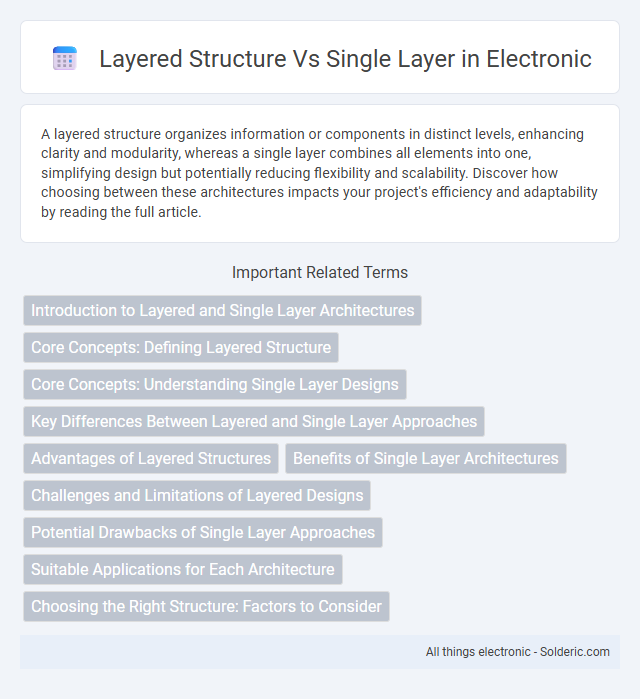A layered structure organizes information or components in distinct levels, enhancing clarity and modularity, whereas a single layer combines all elements into one, simplifying design but potentially reducing flexibility and scalability. Discover how choosing between these architectures impacts your project's efficiency and adaptability by reading the full article.
Comparison Table
| Aspect | Layered Structure | Single Layer |
|---|---|---|
| Definition | Multiple layers stacked for modular design | One uniform layer without segmentation |
| Complexity | Higher due to multiple interdependent layers | Lower, simpler design and implementation |
| Maintenance | Easier updates and debugging by layer | Challenging due to unified structure |
| Performance | Potentially slower due to layer communication | Faster with direct processing |
| Scalability | High scalability through layer enhancements | Limited scalability options |
| Use Case | Complex systems needing modularity (e.g., OS, networks) | Simple apps or hardware requiring speed |
Introduction to Layered and Single Layer Architectures
Layered architecture organizes software into distinct layers, each with specific responsibilities, enhancing modularity and maintainability, whereas single layer architecture integrates all functionalities into one unified layer, simplifying design but potentially increasing complexity in code management. Layered structures often include presentation, business logic, and data access layers, enabling clear separation of concerns and scalability in development. Single layer architectures are commonly used in small-scale applications where rapid development and minimal overhead are priorities.
Core Concepts: Defining Layered Structure
A layered structure divides a system into distinct levels, each responsible for specific tasks, enhancing modularity and ease of maintenance compared to a single layer system where all functions are integrated. Core concepts of a layered structure include abstraction, separation of concerns, and defined interfaces between layers, which promote scalability and fault isolation. Your system can benefit from improved flexibility and manageability by adopting a layered approach over a single layer model.
Core Concepts: Understanding Single Layer Designs
Single layer designs consist of a single conductive layer that simplifies manufacturing and reduces costs, making them ideal for straightforward electronic circuits. This approach limits circuit complexity but enhances reliability due to fewer interconnections and minimal signal interference. Optimal for power supplies and simple control circuits, single layer PCBs emphasize streamlined layouts and efficient use of available space.
Key Differences Between Layered and Single Layer Approaches
Layered structure organizes components into distinct levels, each responsible for specific functions, enhancing modularity and scalability, while single layer approaches integrate all functionalities into one cohesive layer, simplifying design but potentially limiting flexibility. Layered systems support easier maintenance and updates by isolating changes within individual layers, whereas single layer designs may face challenges in isolating faults and implementing upgrades. Your choice depends on the complexity of the project and the need for adaptability versus simplicity.
Advantages of Layered Structures
Layered structures offer enhanced mechanical strength and improved thermal insulation compared to single-layer designs, making them ideal for applications requiring durability and energy efficiency. They provide superior resistance to impact and wear through multiple protective layers, extending the lifespan of materials and reducing maintenance costs. Your project benefits from increased customization options in layered structures, allowing tailored performance characteristics for specific environmental and operational demands.
Benefits of Single Layer Architectures
Single layer architectures simplify design by reducing computational complexity and enhancing training speed, making them ideal for tasks with straightforward patterns. They require less memory and computational resources, which benefits deployment on devices with limited capacity. You gain faster inferencing and easier model interpretation compared to layered structures, essential for real-time applications.
Challenges and Limitations of Layered Designs
Layered structure designs often face challenges such as increased latency and complexity due to multiple processing stages, which can hinder performance and scalability. Managing inter-layer communication requires significant overhead, leading to potential bottlenecks and difficulties in fault isolation. Your system's efficiency might be compromised if these limitations are not properly addressed, especially compared to streamlined single-layer architectures that offer simplicity and direct data handling.
Potential Drawbacks of Single Layer Approaches
Single layer approaches often suffer from limited scalability and reduced flexibility in handling complex tasks due to their simplistic design. These models may struggle with feature extraction, leading to lower accuracy and performance, especially in multifaceted data environments. You might encounter challenges in adapting single layer systems to evolving requirements or intricate problem domains.
Suitable Applications for Each Architecture
Layered structure architecture excels in complex systems requiring modularity, scalability, and ease of maintenance, making it ideal for enterprise-level applications, web services, and large-scale software projects. Single layer architecture suits simple, lightweight applications where rapid development and minimal overhead are priorities, such as small utilities, prototypes, or embedded systems. Your choice depends on application complexity, performance needs, and future scalability plans.
Choosing the Right Structure: Factors to Consider
Choosing the right structure between layered and single-layer depends on factors like project complexity, scalability requirements, and maintenance needs. Layered architectures offer modularity and easier troubleshooting, making them ideal for large applications with multiple functionalities. Your decision should weigh performance impacts and development speed alongside long-term flexibility.
Layered Structure vs Single Layer Infographic

 solderic.com
solderic.com